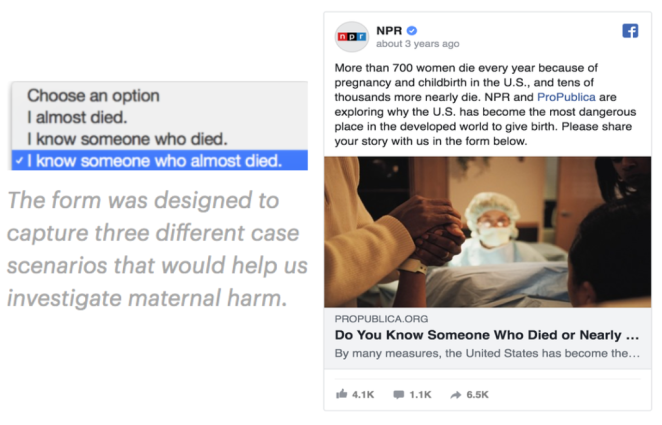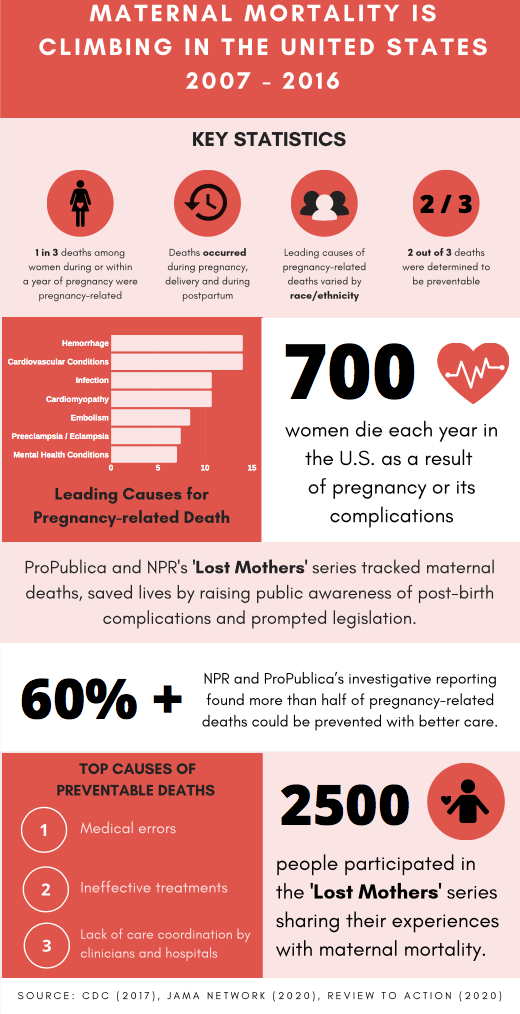Crowdsourcing journalism: Lost Mothers – an investigation to uncover thousands of stories on maternal care
Lauren Bloomstein, a neonatal intensive care nurse, was responsible for taking care of other people’s babies for years. In 2011, at the age of 33, she was finally expecting her own. Her husband recalled, “[it was] the happiest and most alive I’d ever seen her.” On 30 September, at 39 weeks pregnant, Lauren checked in to Monmouth Medical Center in Long Branch, New Jersey. Shortly after, Hailey Anne Bloomstein was born. But the elation of having a new family was sadly fleeting, as some 20 hours later Lauren was pronounced dead from preeclampsia and HELLP syndrome.
What is Journalism Crowdsourcing?
Due to advances in digital technologies and the proliferation of participatory culture, the efficient use of ‘crowdsourcing’ has emerged within a range of contexts, particularly within the field of journalism. Yumi Wilson notes the Tow Center for Digital Journalism defines journalism crowdsourcing as the “…act of specifically inviting a group of people to participate in a reporting task – such as news gathering data collection, or analysis through a targeted open call for input; personal experiences; documents; or other contributions.” Crowdsourcing can be considered an ‘open’ journalistic practice. As Tanja Aitamurto observes, this openness refers to “both public accessibility and transparency during various phases in the journalistic process.”
Mimi Onuoha, Jeanne Pinder and Jan Schaffer note, crowdsourcing can take two forms, an unstructured call-out, “…an open invitation to vote, email, call or otherwise contact a journalist with information” or a structured call-out, which focuses on outreach through targeting individuals to participate in a specific request. Crowdsourcing is notably different from other popular forms of online collaboration. Within crowdsourced journalism, Yumi Wilson declares the locus of control remains in the hands of the journalist, whereby individuals merely contribute their knowledge through unique calls-to-action (CTA), such as voting, witnessing, sharing personal experiences, tapping into specialised expertise or completing a task.
Journalism Crowdsourcing in Practice – ProPublica and NPR: ‘Lost Mothers’
Crowdsourcing enables newsrooms to develop entry points throughout the journalistic process. Mimi Onuoha, Jeanne Pinder and Jan Schaffer, recognise this occurs “…from story assigning, pre-data collection, data mining, sharing specialised expertise, collecting personal experiences and continuing post-story conversations.” The role of new digital and social tools have provided journalists and communities with direct and ongoing access to one another. Crowdsourcing leaders, ProPublica and National Public Radio (NPR), seamlessly balance personal experiences with news developments, in order connect with a wide audience.
The CDC notes the United States has the “…highest rate of maternal deaths in the developed world.” In 2017, ProPublica and NPR collaborated to produce a ground-breaking series, ‘Lost Mothers: Maternal Mortality in the U.S.’, examining a crisis which has previously received very little attention. The six-month long investigative series reported by ProPublica’s, Nina Martin and Adriana Gallardo, alongside NPR’s, Renee Montagne, revealed troubling insights into maternal care, or lack thereof, within the United States. The series started with an engagement team analysing the data that was retrievable from maternal advocacy organisations, as human stories were scarce. Martin, Gallardo and Montagne scoured social media platforms, such as Facebook and Twitter, and crowdfunding sites, including GoFundMe, combing through public posts about individuals experiences with pregnancy complications.
An invitation to contribute followed, asking individuals to share their personal experiences, “Do you know someone who died or nearly died in childbirth? Help us investigate” (Image 1.0). This form of CTA encourages individuals to divulge what they know about a particular topic related to their own life experiences. The published request was formulated as a questionnaire, including questions focusing on the type of maternal complications which may have occurred and subsequently the long-term consequences which continue to linger.

After publishing the questionnaire on ProPublica and NPR’s websites, along with their Facebook pages and Twitter accounts, the series elicited an impressive 2,500 submissions. The response to the request was unprecedented, which was largely attributed to NPR’s impressive reach, having over 6.3 million followers on Facebook (Image 2.0). However, the team were determined to ensure this series received widespread attention, thus they shared the call-out with Cosmopolitan.com, The Texas Tribune and The Root. Each site embedded the questionnaire on their homepage, to which the partnerships resulted in over 200 entries. “The Lost Mothers project has received a total of 5,000 responses”, with stories dating back as far as 1920, Adriana Gallardo told ProPublica.
Maternal Mortality in the United States

The Effectiveness of Crowdsourcing as an Open Journalistic Practice
The notion of crowdsourcing, according to Nina Springer, is underpinned by participants “…agency in contributing to a news story”, accentuating this tool as a form of open, participatory journalism. It has been suggested that news organisations are observing the benefits of situating elements of crowdsourcing outside of the newsroom and directly within their communities. However, it is critical to acknowledge limitations, pitfalls and restrictions which may surface within the journalistic practice of crowdsourcing.
The Potential and Benefits of Journalism Crowdsourcing
Building Connections and Relationships with the Community
Tanja Aitamurto suggests, in some instances, journalism crowdsourcing via social channels is more proactive, thus transforming news gathering and strengthening the reader relationship. This form of community collaboration opens up untapped opportunities for attracting sources with new voices and information, evident in ProPublica and NPR’s series. Martin, Gallardo and Montagne, noticed a critical gap in recipient data, as only 30 percent of responses to the questionnaire were from African American women, who are three to four times more likely to die in pregnancy.
The team shifted the attention of the series into a realm that focused on initiating relationships with key stakeholders, dividing responses into manageable groups (Image 3.0). Working alongside CUNY’s Social Journalism graduate class, the team reached out to hundreds of Facebook groups, such as breastfeeding affinity groups. They were able to be proactive in their engagement and foster relationships. Adrianna Gallardo stated, “I understand the value of making people feel heard, not just the pandering of listening”, which assisted in creating a first of its kind database for lost mothers. Journalism crowdsourcing enables news organisations to give back to their communities, pre-populating databases with information and maintaining connections after projects have concluded.

Foster Diversity and Enhance the Quality of the Product
Journalism crowdsourcing has the ability to foster diversity in news. Journalists may choose to investigate a particular topic that is otherwise not prioritised, whereby different interpretations or alternative angles on news stories are portrayed to the public. The Lost Mothers series illuminated a national disgrace, which was communicated to the public from the angle of intimate narratives. ProPublica concluded, the series encapsulated “…mothers perishing for want of the most basic care and [an] analysis of the social inequities.”
It has been argued that journalism crowdsourcing can be useful to target audience segments who are viewed as experts or are specifically interested in a given topic. Highlighted through ProPublica and NPR’s exclusive call-out, the engagement team were able to tap into the audience’s knowledge, assisting them in the process of information verification. Crowdsourced human-interest stories can appear more attractive for readers. Mimi Onuoha, Jeanne Pinder and Jan Schaffer, state this is through journalists’ abilities to inject a degree of transparency and “…tease out powerful narratives from people.”
Ability to Achieve Real-World Impact
Mimi Onuoha, Jeanne Pinder and Jan Schaffer, infer the success of crowdsourced stories generate “…real-world impact, such as prompting legislative change, than other types of journalism do.” The Lost Mothers series tracked maternal deaths, saved lives by raising public awareness of post-birth complications and prompted legislation. For Marie McCausland, the Lost Mothers article about Lauren Bloomstein’s experience with preeclampsia, encouraged her to seek emergency treatment after she developed similar symptoms post-birth. In an article with NPR, McCausland expressed without this story as a warning, she “…doubts she would have recognised her symptoms or persisted.”
The Lost Mothers series was acknowledged through various awards, including the prestigious George Polk Award, the Polk and Goldsmith Award, the Peabody Award and as a finalist for the Pulitzer Prize. Subsequently, the series also fuelled discussions amongst health care providers and public health experts. As a result, a Texas lawmaker utilised the series to pass maternal mortality-related legislation, lawmakers in New Jersey introduced legislation to overhaul the state’s maternal mortality review process and legislators in Pennsylvania created a maternal mortality review committee.
Limitations, Pitfalls and Restrictions of Journalism Crowdsourcing
Ethical Concerns – Privacy
Nina Springer observes, when building a crowdsourcing project, news organisations “…must be diligent and sensitive about collecting personal information and granting public access to it.” Ethical journalistic practices provide transparency on the participation of contributors and detail how community contributions will be used.
ProPublica and NPR’s questionnaire explicitly stated an individual’s email address, phone, first and last name, would not be used for publication or on social media, unless stated otherwise. Although the questionnaire was not classified as ‘anonymous’, the team asked a series of questions to ensure privacy expectations were upheld. For example, regarding follow up opportunities, the questionnaire asked, “Can we contact you about this story?” and “Would it be OK for us to share your story with other journalists in ProPublica’s reporting network”.
Quality Concerns and the Digital Divide
The accuracy and trustworthiness of user-generated content within journalism, has been questioned. As Nina Springer indicates, tensions have surfaced regarding the use of crowdsourcing, as some fear the audience will have “…too much sway over what the newsroom covers”, while others contemplate the accuracy of individuals contributions.
The call-out for the Lost Mother series was strictly fuelled by personal experiences, alleviating the potential for issues regarding quality to emerge. The relationship between the reporters and those who shared their stories, contributed significantly to the human-interest component of the series, to which their insights contributed to key findings. However, Tanja Aitamurto notes one major restriction, “…is the fact not everybody has equal access to the digital realm”, evident in ProPublica’s and NPR’s series. Social media enabled the team to find many women whose stories would otherwise be lost. Yet, Nina Martin, Emma Cillekens and Alessandra Freitas conclude, this approach was limited in being able to capture those who “…live and die on the margins.”
Sensitivity of Investigation
Open journalistic practices, such as crowdsourcing, have drawbacks and limitations, such as the sensitivity of the topic. For the Lost Mothers series, in many instances the persuasion of encouraging family members to participate was difficult. Martin, Gallardo and Montagne were challenged with breaking down the initial reluctance of sharing personal stories in detail with the wider public due to social stigmas. Anonymity was upheld on a case-by-case basis, whereby ProPublica and NPR only published pictures of women if permission was granted, or if their stories had been told previously. The team shared insights into the project on their Twitter accounts, in order to overcome this constraint and breakdown potential barriers.
Discussion
Amanda Zamora, Senior Engagement Editor who has headed ProPublica’s crowdsourcing efforts in recent years, stated the mission is simple, “…find people in the know.” Through acumen and persistence, ProPublica, alongside NPR in recent projects, have embraced a unique outlook and developed a robust toolkit to transform enterprise journalism through crowdsourcing efforts. The Lost Mothers series sparked an opportunity to bring more voices into reporting and prompted community building, evident through establishing ongoing relationships with associated groups. Soliciting sources and contributions from the public through structured call-outs, such as a questionnaire, assists in creating high-touch points of communication and communities of reliable sources. In turn, Johanna Vehkoo states, it is critical journalism crowdsourcing is approached through a filtered viewpoint, whereby journalists facilitate discussion and determine “…the most trustworthy sources in the chaotic information ecosystem” that is the social and digital environment. Journalism crowdsourcing should be employed carefully across social and digital platforms, with an in-depth understanding of potential benefits, risks and limitations associated with this open practice.


